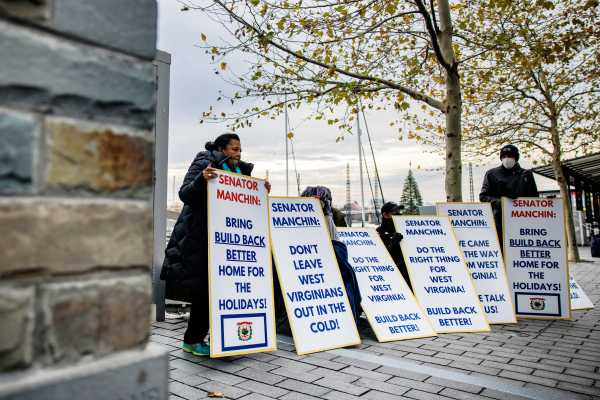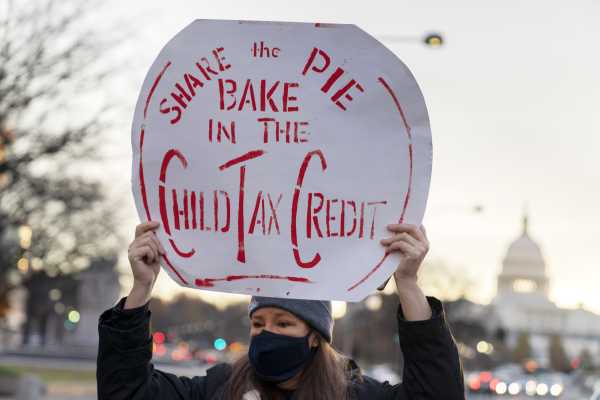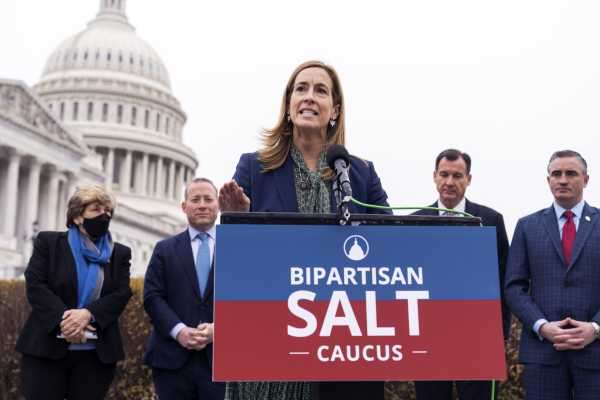
All of the twists and turns in the saga of the Build Back Better Act have just been prologue. Now, it’s time for Democratic senators to determine what will really make it in the final product and whether President Joe Biden’s signature bill will pass at all.
Much of that comes down to Sen. Joe Manchin (D-WV), who expressed skepticism about Build Back Better Wednesday. The bill, he said, would make major changes to three main areas: the tax system, social services, and the energy sector. “We should all be very careful what we do,” Manchin said. “We get any of those wrong, and we’re in trouble.”
Back in August, I wrote that the proposed bill would be “a big fucking deal” if it passed. Various changes and compromises have been made to it since then, weakening or eliminating some — but certainly not all — of its most significant provisions. What remains in the House-passed bill does break down mainly into the three areas Manchin described.
- Social spending: A compromised effort to expand the social welfare state and help families with children, with several new programs created but set to expire in a few years (this includes child care funding, pre-K expansion, and a continuation of the expanded child tax credit) as well as various funding for health care programs (like home-based care through Medicaid and hearing for seniors through Medicare)
- Climate: A lot of money aimed at fighting climate change, primarily through tax credits for clean energy, but not including many punitive policies toward dirty energy
- Taxes: New tax changes that are projected to raise much more money from the very wealthy and corporations but also a large tax cut for well-off people in high-tax (mostly blue) states
Then there’s various other spending on a plethora of different issues and projects, including more money for existing affordable housing programs, and measures to give unauthorized immigrants temporary work permits and increase legal immigration.
But major changes will lie ahead as the Senate hammers out its own version. Manchin’s vote is essential, and he’s said he’s worried the bill creates too many temporary social programs and may seek additional changes to the climate provisions too. That tax change benefiting wealthy blue state residents may be scaled back by senators. And the chamber’s parliamentarian has to determine whether major provisions on immigration and other issues comply with the chamber’s rules. So none of this is set in stone just yet.
New social spending programs — many of which may not last long
Most of the bill’s spending — more than half in the House’s version — is devoted to expanding the social welfare state. (All cost estimates quoted in this article are from the Congressional Budget Office’s analysis.) We can think of that spending as falling into two main buckets: spending to help families with children and spending on health care.
First, many of the most sweeping provisions in the bill have the common goal of financially helping families with children. But there’s a catch: In an effort to please moderates who demanded the overall cost of the bill be kept down, Democrats have set several of these programs to last for only a limited time, gambling that they’ll end up being popular and that Republicans will agree to let them continue if they hold power later. They include:
The expanded child tax credit: As a pandemic relief measure, Congress expanded the child tax credit for this year, making it significantly larger (for all families except the rich) and having it go out in monthly payments. They also made the credit available even to poor families earning no taxable income at all (who had so often been left out of previous antipoverty policies due to work requirements). But these changes are set to expire at the end of this year.
The Build Back Better Act would also make the credit’s increased availability to the poorest families permanent. Many antipoverty crusaders and policy wonks think this latter part is the best social spending in Build Back Better, with one estimate saying it could cut child poverty in the US by 19 percent.
The bill would also keep the “supersized” child tax credit for all but the wealthiest families going — but just for one more year. So overall this adds up to a cost of about $184 billion over 10 years. (If the expanded child tax credit was expanded for a full decade, it would cost more than $1 trillion in that span.)

The child care plan: The bill includes an ambitious plan to help millions of families with children under age 6 get affordable child care for the first time, subsidizing most or all of the cost of their care at licensed providers. It’s also a plan that’s been the subject of intense debate, as I wrote recently — critics fear it could lead to shortages or drive up prices while supporters argue that an influx of federal money would improve a broken system.
The catch here is that the bill only fully funds this plan for three years — 2025 to 2027. In the three years before that, subsidies will gradually be expanded to more Americans. But in 2028, the subsidies vanish. So on paper, the childcare plan costs $273 billion over 10 years, per CBO, but a fully funded version would likely cost more than $600 billion.
Expanded pre-K: The bill also devotes about $109 billion to funding state expansions of pre-K programs — though here too, the federal money will vanish after six years, in 2028. The White House argues that this would provide “universal pre-K” but there are questions about whether they can truly make good on that promise, as my colleague Fabiola Cineas has written.
Paid leave: Finally, the House bill also has the federal government, working through private insurers, help fund paid leave for workers who become new parents or who are seriously ill. But Manchin has said he is opposed to including this at all, and the White House has already agreed to drop it, at his behest. So it seems this won’t end up in the final version.
Health care is the other major category of the bill’s new social spending. The biggest-ticket item is about $146 billion for in-home care for seniors and the disabled through Medicaid. The bill would also expand Medicare to cover hearing benefits, fund the subsidies that help people pay for Obamacare individual insurance plans for a few more years, allow the federal government to negotiate some prescription drug prices in the hopes of driving those prices down, and pay for coverage for low-income individuals in states that did not expand Medicaid.
The potential trouble ahead is that Manchin has said he’s not thrilled with the approach of funding many programs only for a few years (though this is not uncommon congressional budgeting practice). He said Democrats have relied on “shell games” and “budget gimmicks” to hide the true costs of their bill. If he holds firm on this, it could mean major changes to this part of the bill — certain programs may have to be dropped entirely.
Democrats have protected a lot of money to clean energy
Significantly, as Democrats have been forced to pare back the overall size of Build Back Better, they have protected the overall amount of money they’re devoting to climate: Nearly $500 billion over 10 years (about a quarter of the bill’s spending) is devoted to green energy or other measures meant to fight climate change.
The bulk of that money goes to tax credits meant to incentivize clean electricity and transportation as well as energy efficiency for property owners. And in contrast to their treatment of social policy programs, Democrats are not setting their new clean energy tax credits to expire after just a few years. The bill would create a tax regime for clean energy that would last the next 10 years. (More specifically, the bill would extend and enhance existing tax credits, which are often targeted to specific technologies, for the next five years, but it would create a new technology-neutral approach for such tax credits after that.) There’s also spending on reducing pollution, forest restoration, and other conservation programs.
Yet while the amount of money devoted to climate has stayed the same, the form of that spending has changed. At Manchin’s behest, Democrats have backed down from proposals that would be punitive toward dirty, emission-heavy energy. Most notably, they’ve abandoned what had been their centerpiece climate proposal: a “clean electricity payment program” that would make payments to utilities that rely on clean energy, while fining those that aren’t making progress toward reducing carbon emissions. That’s out. Loose talk of including a carbon tax of some kind never went anywhere, either.
The major punitive policy toward dirty energy that remains in the bill is a fee on methane emissions associated with oil and gas production and transmission. Though carbon dioxide emissions are mostly responsible for climate change, methane emissions play a significant role as well — they’re at least 80 times more effective at trapping heat than carbon dioxide, my colleague Rebecca Leber recently wrote. Democrats hoped to discourage such emissions with a new fee, but they need Manchin’s approval, so they’re working to win him over. (He said Wednesday that Democrats have made “some good adjustments” on the methane fee but didn’t sound completely won over just yet.)
The big picture is that the climate provisions of the current bill fall short of what progressives hoped was possible earlier this year, but they’re still sweeping, important, and would be quite impressive for a Senate that needs a vote from Manchin — who represents a state where the coal industry is tremendously important and who himself has made millions from coal companies he founded.
But of course, nothing is final.
A tax hike for the very wealthy and corporations, a tax cut mostly benefiting wealthy blue staters
On the one hand, the Build Back Better Act would raise a great deal of revenue from higher taxes on some of the wealthiest people in the country and on corporations. On the other hand, the bill would massively cut taxes for many less wealthy but still quite well-off people — because of its changes to what’s known as the SALT (state and local tax) deduction.
The background here is that President Trump’s 2017 tax cut bill made a significant change limiting how much state and local taxes were deductible on federal tax returns. This meant a bigger tax bill for well-off people who live in places where taxes are high — usually blue states or cities. (The change mostly hits well-off people because they often itemize their taxes and pay higher rates.)
So House Democrats representing these high-tax areas (for instance, New Jersey) demanded a significant portion of the bill’s spending be devoted to rolling back this change over the next five years. This change would cost $229 billion in that span, making it of comparable size to Democrats’ childcare plan. “Roughly 98 percent of the benefit from the increase would accrue to those making more than $100,000 per year, with more than 80 percent going to those making over $200,000,” per the Committee for Responsible Federal Budget analysis.

The Senate Democratic Caucus, which includes several Democrats in rural lower-tax states, is less “SALT-y,” and key senators have discussed scaling back this change. It isn’t clear where they’ll land yet. For now, though, one of the groups that benefits most clearly from the House-passed bill is wealthy people in blue states.
To be clear, though, the overall bill is no giveaway for the richest. Changes to taxes on high-income individuals would raise an estimated $640 billion more in revenue over the next decade, per CBO. This breaks down into about $252 billion from changes to the net investment income tax, $160 billion from limiting excess business losses, and $227 billion from a “surcharge” on wealthy individuals, estates, and trusts, which would apply to about the wealthiest 0.2 percent of Americans. These tax policies were crafted to please Sen. Kyrsten Sinema (D-AZ), who opposed plans to raise tax rates and preferred these somewhat more obscure workarounds.
Additionally, corporate tax changes would raise an estimated $813 billion more revenue over the next decade. This includes about $318 billion from a corporate alternative minimum tax, $124 billion from an excise tax on the repurchase of corporate stock, and $211 billion from changes to how foreign-derived income is taxed. All that totals to about $1.4 trillion in new revenue from taxes on corporations and the wealthy, far more than the SALT tax change will cost.
And there’s more
The social welfare state, climate, and tax changes make up the most significant chunks of the bill in dollar terms, but there’s, of course, a great more in it that would affect millions of people — far too much to fully outline here. The bill would also spend billions on housing, public health, higher education, and transportation projects, and it would tax e-cigarettes.
Democrats hope the bill will make significant changes to immigration policy too. They’ve been negotiating with the Senate parliamentarian to try to find a version of their proposed changes that she says can go through the special, filibuster-proof budget reconciliation process being used for this bill.
As my colleague Nicole Narea has written, the parliamentarian has also rejected the Democrats’ first two proposals — creating either a path to citizenship or a green card for millions of unauthorized immigrants. Their current plan would allow unauthorized immigrants to apply for temporary deportation protection that would let them work and last for five years. The proposal would also expand legal immigration, in part by “recapturing” millions of green cards that have gone unused in recent decades.
Theoretically, Democrats could override a ruling by the parliamentarian, but Manchin has said he will not do so. Even if Democrats’ proposals get a thumbs-up from the parliamentarian, they’d still have to get Manchin’s vote. So what lies ahead for immigration in Build Back Better is unclear.
Then again, that’s true for the entire bill. With no votes to spare in the Senate, everything hinges on what Manchin and Sinema will accept. Nothing is final until everything is final. And a great deal more intense negotiation lies ahead.
Will you support Vox’s explanatory journalism?
Millions turn to Vox to understand what’s happening in the news. Our mission has never been more vital than it is in this moment: to empower through understanding. Financial contributions from our readers are a critical part of supporting our resource-intensive work and help us keep our journalism free for all. Please consider making a contribution to Vox today to help us keep our work free for all.
Sourse: vox.com






